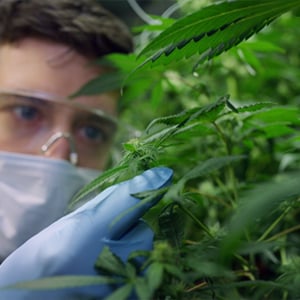Here we are focusing on the specifics of crop steering for vegetative growth. What cues can you use to encourage plants to rapidly produce leaves and roots?
 Crop Steering for Vegetative Growth
Crop Steering for Vegetative Growth

Article from | TSRgrow
Crop steering in cannabis allows cultivators to push and pull their plants back and forth between vegetative and generative growth to produce targeted outcomes. Applying subtle adjustments to irrigation, climate, and lighting makes it possible to create the exact outcomes you seek throughout the lifecycle.
Here we are focusing on the specifics of crop steering for vegetative growth. What cues can you use to encourage plants to rapidly produce leaves and roots?
Vegetative and Generative: Two Sides of Crop Steering
Cannabis cultivators use crop steering tactics to cue plants into different types of growth: vegetative and generative.
Vegetative describes growth you'd expect to see during a traditional veg phase, which means lots of leafy, bushy development. Plants grow taller, strengthen their root system, and produce foliage. Generative refers to growth you'd expect during flower, focusing on bud sites and flower development, with less focus on leaf production.
Vegetative cues all revolve around reducing environmental stressors in the grow room. It's about optimizing all environmental inputs to promote rapid, prolific growth. On the other hand, generative crop steering uses strategically targeted stressors that convince the plants to focus on reproduction rather than leaf development.
Technically speaking, applying crop steering principles makes it possible to produce vegetative and generative growth at any point in the plant's life cycle. It's not just vegetative in veg and generative in flower. For example, following a hard pruning in the early weeks of flower, cultivators may use environmental cues to convince their plants to focus on a few days of vegetative growth.

Cannabis Crop Steering Cues for Vegetative Growth
There are three components to crop steering: irrigation, climate, and lighting. What cues can you apply under each of these categories to stimulate vegetative development?
Irrigation Cues for Vegetative Growth
There are three core tenants to irrigation: frequency, volume, and/or timing of watering. As a general rule, the more you water, the more you will cue your plants to vegetative. For example, irrigating as frequently as every thirty minutes during lights on.
Vegetative also requires lower substrate electrical conductivity. Both irrigation and fertigation influence substrate EC. Increase irrigation runoff volume during vegetative to lower EC levels.
As for dry backs, which is the period between the last irrigation period of the day and the next one, you'll want to aim for anywhere between one to four percent. Your substrate choice and pot size will influence the targeted dry back.
Climatic Cues for Vegetative Growth
Humidity and temperature intersect to impact vapor pressure deficit (VPD). In the grow room, VPD predicts how much or how little your plants will transpire. Vegetative requires lower VPD, meaning plants transpire less and retain more water.
Another climatic cue for veg is slightly higher temperatures than you'd have in flower, both throughout the grow room and in the root zone.
Lighting Cues for Vegetative Growth
Lighting also cues plants to enter or end vegetative growth. During vegetative, cannabis needs lower intensity lighting but a much longer photoperiod than in flower. By scheduling lights on for eighteen hours and off for six, you give plants a maximum amount of time to photosynthesize and convert light into energy.
Another cue that straddles the climate and lighting categories is the difference between daytime and nighttime temperatures. During the vegetative cycle, reduce the temperature differential between lights on and lights off.
Keep in mind that there is no one-size-fits-all approach to crop steering. There are still a lot of differing opinions among experienced indoor growers on the specifics of this methodology. Therefore, the above cues should simply serve as the basis from which to plan your own experimentation for vegetative growth.
Real-Time Grow Room Data Drives Crop Steering
The success or failure of any crop steering attempt boils down to the data pulled from the grow room. The level of real-time detail you can draw about irrigation, EC, VPD, temperature, and lighting will direct where you take your room, and how precise you can get with steering.
TSRgrow TOTALgrow Solution is a total grow room solution designed to facilitate crop management, data analysis, and complete cannabis cultivation control. Our advanced zone-controlled LED lighting, combined with GROWHub, our environmental monitoring system, delivers complete control into the hands of the cultivator.
The TSRgrow grow room ecosystem ensures that you can steer in a strain-specific manner, even within a large commercial warehouse space. Every fixture allows for total zone control, so growers can dial in the settings for each cultivar in each growth stage.
However you apply the principles of crop steering in your own facility, TSRgrow delivers the tools to compare and review crop data to continue experimentation until you achieve perfection.
The content & opinions in this article are the author’s and do not necessarily represent the views of AgriTechTomorrow
Comments (0)
This post does not have any comments. Be the first to leave a comment below.
Featured Product

